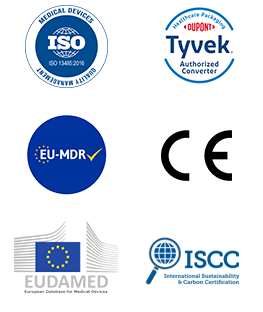Content
1. Grondstoffen en productie: strikte screening van houtpulp van medische kwaliteit
- Grondstofnormen en bereidingsproces
Medisch crêpepapier gebruikt pure houtpulp als belangrijkste grondstof en moet aan de volgende eisen voldoen:
Vezellengtecontrole: Gebruik naaldhoutpulp (zoals grenen) en hardhouthoutpulp om te mengen, en controleer de vezellengteverhouding op 3:1 om de balans tussen papiersterkte en zachtheid te garanderen.
Geen vervuiling door additieven: Het is verboden chemische additieven zoals fluorescerende witmakers en weekmakers te gebruiken om reacties met medische hulpmiddelen te voorkomen.
Speciaal verpulpingsproces: Door middel van verpulping met een lage concentratie (concentratie ≤4,5%) en trapsgewijs fijn slijpen worden de vezels verdeeld en bezemd om een poreuze en ademende structuur te vormen (openingsafwijking ≤±15%).
- Rimpelvormende technologie
Rimpelen bij hoge temperaturen: het papierweb wordt gerimpeld door een schraper bij 150-180 ℃ om een uniforme rimpelstructuur te vormen en de rek te vergroten (longitudinaal ≥12%, transversaal ≥8%).
Online detectie: Lasersensoren worden gebruikt om het gramgewicht (60±2g/m²) en de luchtdoorlaatbaarheid (≥50μm/Pa·s) in realtime te monitoren om batchconsistentie te garanderen.
2. Aanpasbaarheid van de sterilisatie: kernontwerp compatibel met meerdere sterilisatiemethoden
Sterilisatie met ethyleenoxide (EO).
Microporiënpenetratie: De poreuze structuur van het crêpepapier zorgt ervoor dat EO-gas snel kan binnendringen en de resterende hoeveelheid na sterilisatie is ≤4μg/cm².
Bacteriële barrière: Volgens de ISO 11607-test is de barrière-efficiëntie van de Bacillus subtilis zwarte variant ≥99,9%.
Stoomsterilisatie onder hoge druk
Natte hittestabiliteit: Na 5 cycli van 121℃/30min heeft het papier geen delaminatie en is de afpelsterkte ≥1,5N/cm.
Anti-condensatie ontwerp: De gerimpelde structuur kan gecondenseerd water absorberen om te voorkomen dat het instrument nat wordt (wateropname ≤20g/m²·60s).
Andere sterilisatiemethoden
Bestraling met gammastraling: Bij een bestralingsdosis van 25 kGy bedraagt het behoud van de treksterkte ≥80%.
Waterstofperoxideplasma: Uit compatibiliteitstesten blijkt dat er geen sprake is van materiaaldegradatie.
3. Belangrijke knooppunten in de toeleveringsketen
Einde productie van medische hulpmiddelen
Automatisering van de verpakking: Crêpepapier kan in specifieke vormen worden gestanst en worden aangepast aan automatische verpakkingslijnen (zoals vouwmachines voor chirurgische instrumenten), met een efficiëntie van 200 verpakkingen/minuut.
Kostenoptimalisatie: vergeleken met niet-geweven stoffen kost crêpepapier 30% minder en kan het na sterilisatie direct worden verbrand (asgehalte ≤0,5%).
Ziekenhuis Sterilisatie Supply Center (CSSD)
Gestandaardiseerde werking: dubbellaagse verpakking volgens WS 310.3-specificaties, binnenlaag van crêpepapier, buitenlaag van niet-geweven stof, waardoor de steriele houdbaarheid wordt verlengd tot 6 maanden.
Traceerbaarheidsbeheer: Sommige crêpepapieren zijn voorbedrukt met sterilisatie-indicatorlabels (zoals kleurveranderende inkt) om het sterilisatieproces te visualiseren.
Klinische gebruiksscenario's
Operatiekamer: gebruikt voor het verpakken van instrumententrays, scheursterkte ≥ 400 mN, om schade tijdens de operatie te voorkomen.
Tandheelkundige kliniek: verpakking in één vel van kleine instrumenten (zoals naalden), gemakkelijk te openen om de efficiëntie van de medische zorg te verbeteren.
4. Medisch crêpepapier FAQ (veelgestelde vragen)
Wat is medisch crêpepapier?
Medisch crêpepapier is een speciaal papier dat speciaal wordt gebruikt voor het steriel verpakken van medische hulpmiddelen. Het is gemaakt van pure houtpulp en heeft een poreuze, ademende structuur. Het is geschikt voor een verscheidenheid aan sterilisatiemethoden, zoals stoom, ethyleenoxide (EO) en gammastraling. De kernfunctie ervan is het bieden van een microbiële barrière om ervoor te zorgen dat het apparaat steriel blijft tijdens transport en opslag.
Wat zijn de voordelen vergeleken met katoenen stoffen verpakkingen?
Sterkere antibacteriële eigenschappen: crêpepapier heeft een kleinere poriegrootte en een microbiële barrière-efficiëntie van ≥99,9%, terwijl katoenen stoffen gemakkelijk vezels verliezen en een bacteriële drager worden.
Betere sterilisatiepenetratie: De poreuze structuur maakt 100% penetratie van sterilisatiemiddelen (zoals stoom, EO) mogelijk, waardoor het probleem van de "natte zak" wordt vermeden.
Milieubescherming: wegwerpgebruik, asgehalte ≤0,5% na verbranding, terwijl katoenen doek herhaaldelijk moet worden gewassen en een hoog energieverbruik heeft.
Kan crêpepapier gerecycled worden?
Niet recyclebaar. Hoewel het gemaakt is van houtpulp, kunnen er na sterilisatie chemische stoffen achterblijven en moeten ze als medisch afval worden behandeld.
Bevat het giftige stoffen?
Gekwalificeerde producten moeten slagen voor de GB/T 24992-test op arseengehalte en mogen geen afschilfering of geur vertonen.

 English
English Français
Français Deutsch
Deutsch Nederlands
Nederlands

 ‘S-Gravenweg 542, 3065SG RotterdamNederland
‘S-Gravenweg 542, 3065SG RotterdamNederland
 +31 (0) 10 254 28 08
+31 (0) 10 254 28 08







